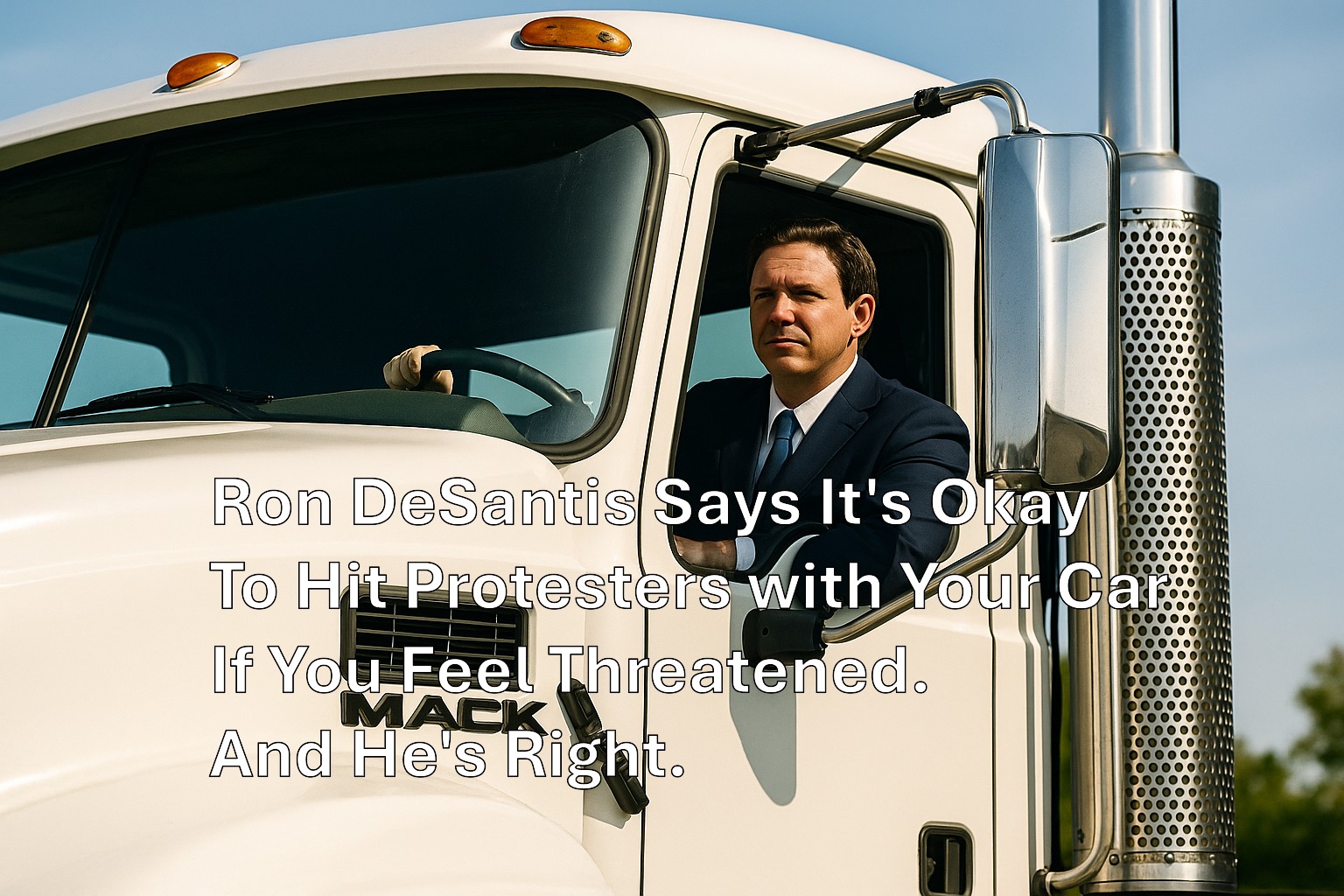
When a violent mob surrounds your car, do you sit there and hope for mercy — or do you hit the gas?
Governor Ron DeSantis has again shown why so many Floridians trust his leadership. In his words: if a mob blocks your car and you fear for your life, you’re allowed to drive through it. Critics are howling — but the law, common sense, and basic human rights are firmly on DeSantis’ side.
First Amendment Rights Have Limits — And Protest Is No Exception
It’s true that protesters have First Amendment rights. But those rights end where unlawful violence, obstruction, and intimidation begin. The Supreme Court has repeatedly upheld this. A constitutional lawyer will tell you: the First Amendment is powerful, but it is not a blank check for lawlessness.
In Madsen v. Women’s Health Center, Inc., 512 U.S. 753 (1994), the Court emphasized that time, place, and manner restrictions on protest are perfectly valid — especially where public safety is at stake. The Court upheld injunctions creating buffer zones around clinics, noting that such measures were justified by the government’s “strong interest in ensuring the public safety and order, in promoting the free flow of traffic on public streets and sidewalks, and in protecting the property rights of all its citizens.” Id. at 768.
Likewise, in Walker v. City of Birmingham, 388 U.S. 307 (1967), the Court acknowledged the “strong interest of state and local governments in regulating the use of their streets and other public places,” and that when protest “takes the form of mass demonstrations, parades, or picketing on public streets and sidewalks, the free passage of traffic and the prevention of public disorder and violence become important objects of legitimate state concern.” Id. at 315.
Translation: You can chant all you want — but you can’t turn a city street into a war zone or a trap.
Self-Defense Is a Fundamental Right — Including Against Mobs
Critics have cried that DeSantis is encouraging vigilante justice. In reality, he is defending one of the most ancient, universal rights known to law: the right to defend oneself.
The Supreme Court’s landmark decision in District of Columbia v. Heller, 554 U.S. 570, 628 (2008), reminds us: “the inherent right of self-defense has been central to the Second Amendment right.” And while Heller addressed firearms, the principle applies across the board. A vehicle used to escape a mob is no different from a firearm used to fend off an attacker — both are tools of lawful defense when faced with imminent harm.
Justice Scalia underscored the point in Montana v. Egelhoff, 518 U.S. 37, 56 (1996), observing that “the right to have a jury consider self-defense evidence … is fundamental.” Put simply: if you can credibly testify in court that you reasonably feared that protesters surrounding your vehicle intended to harm you and were likely to act on that threat, then you had every right to floor it and escape — even if doing so injured or killed one or more protesters. You are a human being, not a clay pigeon.
No One Should Be a Sitting Duck
Governor DeSantis’ stance is basic common sense:
- If a protest is peaceful, no one will be in danger.
- If a protest becomes a violent mob, and a driver reasonably fears for their life, they have every right to escape — even if that means pushing through the crowd.
Florida law reflects this. Under Florida’s stand your ground statute (Fla. Stat. § 776.012), a person has no duty to retreat and may use force, including deadly force, if they reasonably believe it is necessary to prevent imminent death or great bodily harm.
And recent legislative efforts — such as Florida’s Combatting Public Disorder Act — further underscore that drivers fleeing violent mobs will not be prosecuted unless their actions are “intentional” and malicious — not a good-faith attempt to save their own lives.
The Legal Landscape: Real-World Cases
There have been numerous examples where individuals who believed they were in danger were not prosecuted after driving through protesters:
- Tulsa, Oklahoma (2020): A man drove his truck through a crowd of protesters blocking an interstate, injuring several people. The Tulsa District Attorney declined to press charges, citing Oklahoma’s self-defense statute and concluding that the driver reasonably believed the use of force was necessary to protect himself and his family from imminent bodily harm.
- Gainesville, Florida (2020): Prosecutors dropped six counts of aggravated assault against a driver who drove through a protest, explicitly citing Florida’s Stand Your Ground law as a factor in the decision.
- Eugene, Oregon (2020): A grand jury refused to indict a driver who struck a protester during a march, despite prosecutors urging charges.
Protesters attempting to block traffic, burn cities, and menace innocent people — you are officially on notice.
Conclusion: DeSantis Is Right — And It’s Time Other Leaders Caught Up
Governor DeSantis’ message is simple: no one should be forced to sit and hope for mercy while surrounded by a violent mob.
The First Amendment does not license protesters to become assailants. When they cross that line — when they block streets, bash on cars, and terrify drivers — they forfeit any shield of constitutional protection. And the right to self-defense takes over.
The Supreme Court has reminded us that the right to self-defense is “fundamental.” DeSantis is merely standing up for that truth. And for every Floridian who drives the streets, that’s something to be thankful for.
Image Credit: OpenAI DALL·E.
 Law Office of Jason Ostendorf LLC
Law Office of Jason Ostendorf LLC